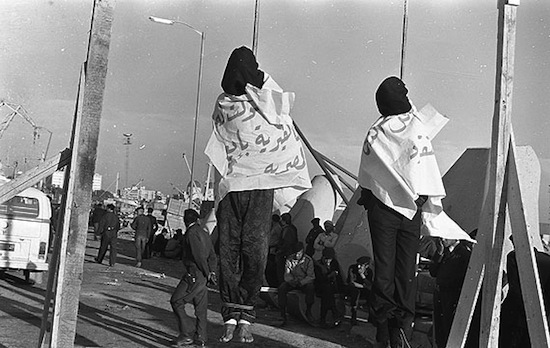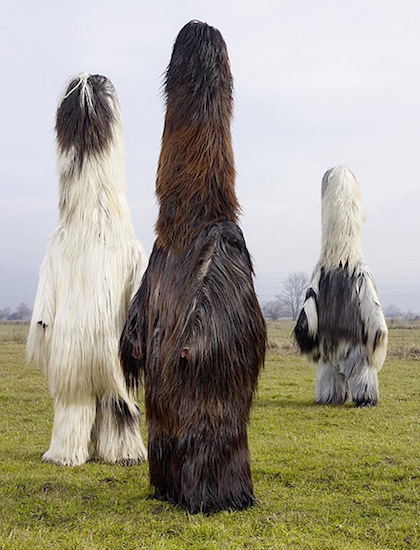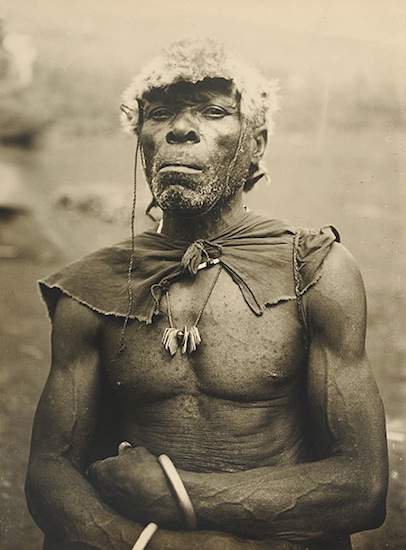
Poster of Bachar al-Assad, Damascus, 2007 © Nicolas Righetti
Photo Museum Antwerp Waalsekaai 47 2000 Antwerpen Belgique
Power! Photos! Freedom!
Marco Bohr » Florian Göttke » Nermine Hammam » Nicolas Righetti » Hrair Sarkissian » Issa Touma » Joachim Ben Yakoub » Mosireen » Uprising of Women in the Arab World »
While photography is a medium that can play games of hide and seek and manipulation, it also mobilises people. It is used to tell a story that can only be told in images, inside and outside of the political arena. Power! Photos! Freedom! goes in search of the power of the image in a rapidly changing Arab world. Photography has the power to make or break regimes. Whilst the ubiquitous image of the dictator may create a personality cult around leaders in authoritarian regimes, photography can also serve as a primary catalyst for revolutions and uprisings. An anonymous graffiti artist in the streets of Cairo captures it well: a gun on the left (“their weapons”), a camera on the right (“our weapons”).

Lybia, Benghazi, 1977
© Courtesy of Peter Bouckaert/Human Rights Watch
A cheering crowd in a Libyan sports stadium, gazing hopefully in the direction of their leader. Thus began the dubious political career of Muammar Gaddafi (LY, 1942-2011), in 1969, a career which would end 42 years later in blood and gore. The Gaddafi Archive contains thousands of photographs that reconstruct his entire career. Peter Bouckaert, Human Rights Watch's emergencies director, and his team took this archive into custody on behalf of the Libyan people. Curator Susan Glen has made a selection and provided the historical context.

Leonid Brezjnev and Muammar al-Gaddafi, Moscow, 1981
© Courtesy Michael Christopher Brown/Human Rights Watch
Alongside these archives, Power! Photos! Freedom! presents a dozen photographic projects on Tunisia, Egypt, Syria and Libya. We see a region that has undergone tumultuous change in the past decade through the eyes of both insiders and outsiders. It would seem that photography is never innocent. What was the actual situation? Who was photographed? Why was this particular picture chosen? And in what context was the photograph distributed? The road paved by a single image is one of constant validation and reversal of meaning.
Arab Spring or Arab Winter, all seasons have been used to name the uprisings. But winter or spring, freedom is the clarion call that is echoing around the halls of politics, around your own living room and, of course, within the frame of a photograph.

Babugeri, Bulgarie, from the series Wilder Mann, 2010-2011 © Charles Fréger
Charles Fréger
Wilder Mann
Who are these people, covered in heavy animal skins or straw skirts and adorned with cow bells or goat's legs? Charles Fréger (FR, °1975) accompanied traditional groups to remote, unspoilt places. The rituals create a sense of unity with the land, with the ancient customs and with each other. Fréger shows us a forgotten slice of European culture, which is as close as it is alive. In 2010 and 2011, Charles Fréger crossed the continent in search of people who uphold ancient local traditions. Their rituals are variations on the same theme: the changing of the seasons, fertility or the struggle between man and nature. Fréger collects these masquerades under the header Wilder Mann, referring to a character from Germanic mythology. Being half-animal, half-man, born from the union of woman and bear, the wild man epitomizes man's animal side.

Cerbul din Corlata, Romania, from the series Wilder Mann, 2010-2011 © Charles Fréger
Fréger chooses his characters and locations carefully. Only natural materials such as straw, moss, animal fur or horns, bells and bones will do. As the costumes contrast, or blend, with the landscape, they are done full justice. Every detail has been studied; lighting and composition leave nothing to chance: the beasts appear in harmony with the landscape. The characters in Wilder Mann exude strength and virility and become etched on your brain.
Over a period of more than a decade, Charles Fréger has built an extensive body of work, `Portraits Photographiques et Uniformes´ in which he portrays diverse groups of people. In Wilder Mann, he explores the boundaries of the portrait by only putting the masquerade on display.

Bashi (Banyabongo), Belgisch-Kongo (Kivu), ca. 1945/50
© ROSMANT (BE, unknown) / collection Fotomuseum Antwerpen
Camera Exotica
A Western European image of the world in photos [1850-1960]
Selection from the FoMu collection
Photography played an important role in the western European perception of the exotic worlds, because it opened up a dialogue about what is 'foreign' and fuelled people's imagination in the process. The FoMu shows a selection of photographs from its own collection going back to the very beginning of photography up until the 1960s.

Anonymous: Western man wearing oriental cloths, Daguerrotype, ca. 1845
© De kunstenaar / FotoMuseum Provincie Antwerpen
All through history, man has been fascinated by the exotic, the unknown and ‘the other’. Different causes and motives move people to leave their trusted environment and discover unknown worlds, and they are always accompanied by ambivalent emotions. From its very beginnings in 1839, photography has played an important role in the development of a European image of the exotic. Photos did not only contribute to the opening up of these exotic worlds and their depiction, but at the same time, they are a manifestation of the ambiguous western self-image. Photos tell us often more about their photographers and the image the West had of ‘the other’, than about the worlds they show in themselves. The FoMu keeps a large collection of photographic images and documentation from the period between 1850 and 1960. Supplemented with various items borrowed from other museums and private collections, this exhibition sets out a few strong markers surrounding this captivating theme.
To coincide with the exhibition a book is published. It is for sale in the Museumshop for 16 euros.

